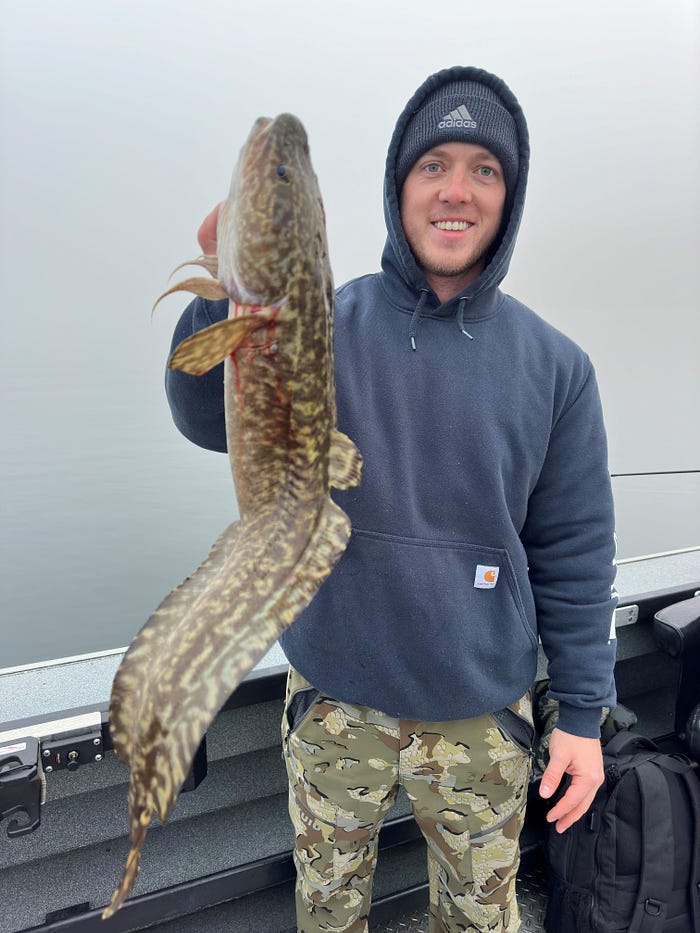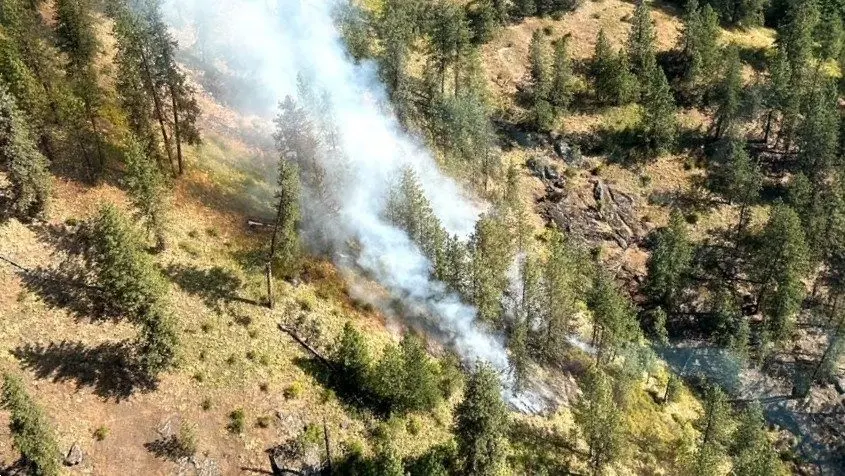In the wintertime around Eastern Washington, trout, yellow perch, and walleye garner most of the attention, but there’s a less familiar species that anglers shouldn’t overlook.
Unlike a lingcod, however, burbot (lota lota) are in the cod family (Gadidae), distinguished by their single chin barbel. Lingcod are in a family with greenlings (Hexagrammidae).
The burbot has a flattened head, a single chin barbel and an upper and lower jaw filled with small teeth. On the top of their serpent-like body are two dorsal fins — a short one followed by a long fin that stretches to the back. On the bottom is another long fin ending at the base of a rounded rear tail fin.
Burbot are a long-lived fish and reach maturity in two to four years or about 11 to 16 inches in length, with some reaching six to seven years of age at 21 to 25 inches, and a few exceeding 10 years. A Washington Department of Fish and Wildlife (WDFW) survey in the 1990s showed the oldest burbot recorded to date came from Keechelus Lake near Cle Elum. It was estimated to be 19-years-old and measured 29.17 inches.
The average weight of a burbot is two to eight pounds, but they’re known to grow much larger. Mike Campbell holds the Washington state record burbot. It weighed 17.37 pounds, and he caught it at Bead Lake in Pend Oreille County on April 24, 2004.
In North America, burbot are found across the northern United States and Canadian provinces from Alaska south to Washington and Wyoming, and east to Connecticut.
According to a WDFW stock status report, Washington’s burbot population likely originated from dispersion of fish in the southern unglaciated portion of the Columbia River following the last Fraser glaciation. Only northern lakes and reservoirs in Washington are known to contain burbot and their expansion to more southerly regions is probably limited more by higher water temperatures than geographic barriers.
Burbot catches are very low in all Washington waters they inhabit, although there is a core group of anglers who target them mainly in the winter, but most are caught incidentally.
In the 2023 “WDFW Participation and Preferences of Washington Anglers” report, burbot ranked less than one percent of the “most preferred” fish by anglers to catch. The top five fish were rainbow trout, salmon, bass, walleye, and kokanee.
“Burbot isn’t a fish species of concern in the waterways they inhabit around Washington, and from a sportfishing standpoint it is definitely an underutilized fish species,” says Danny Garrett, a WDFW biologist in Spokane. “There is very little effort and interest in catching them, but there are several lakes that provide an excellent opportunity to target this good (or fine) eating fish, mainly in the wintertime.”
Beauty truly is skin deep when it comes to a burbot. Despite their slimy outer appearance, these fish have a mild, white, flaky flesh that is surprisingly like their ocean-faring cod cousins and are excellent table fare.
Did somebody say, “fish and chips!”

There are 11 known burbot lakes in Washington, all in the northern Columbia River drainage, the upper Yakima River basin, and the Pend Oreille region. No burbot has been documented in Western Washington, although they’re found in the Skeena and Nass River drainages of western British Columbia.
Burbot tend to prefer deep and cold water at depths of 100 feet or more — though they are known to move into shallower water at night — and waterways that house an ample food base of small-sized prey fish, crayfish and amphipods, copepods and cladocerans.
Lakes with burbot include Banks in Grant County; Bead and Sullivan in Pend Oreille County; Chelan in Chelan County; Cle Elum, Kachess and Keechelus in Kittitas County; Roosevelt in Stevens, Ferry, Lincoln, Grant, and Okanogan counties; Osoyoos and Palmer in Okanogan County; and Rufus Woods Reservoir in Douglas and Okanogan counties.
Anglers should always check the printed WDFW sportfishing regulation pamphlet or WDFW website, but the daily limit is five with no size limit restriction.
“Fishing can be quite excellent in some eastside lakes, if you know where and when to look,” said Bill Baker, a WDFW biologist in Northeast Washington. “Winter is an excellent time to fish for burbot, as they tend to congregate leading up to and during spawning.”
In Lake Roosevelt, the Spokane Arm holds a good number of burbot during the winter and it is primarily a boat fishery for these deep-dwelling fish. Another winter fishing area is located at the mouth of the Colville River, which can be fished either from a boat or off the shore.
“The Lake Roosevelt burbot population is robust, but fish size is generally on the smaller side, with most individuals maxing out at around 26 inches and lots of fish around 20 inches,” Baker says. “Much of the shore fishing is done at night, as burbot tend to be most active during dusk, dawn, and nighttime. Near the mouth of the Colville River, you’ll see where anglers have had campfires on the shore.”
Shore fishing is mostly done by plunking cut bait or worms. Boat anglers may also use that technique or try more active ones such as jigging with a jig heavy enough to get down and baited with a soft plastic lure, tipped with worm or other bait.
Sullivan Lake rarely freezes over, and in winter anglers tend to focus their effort on the southern end of the lake near the primary inlet around Harvey Creek. You can drive right to it, so it’s very accessible.
The burbot population at Sullivan is stable, according to Baker, and in some years, produces some good-sized fish. However, this can vary year to year and seems to be driven by year-class strength.
Due to Bead Lake’s large size and volume, it tends to freeze over mainly later in the winter fishing season. Most anglers fishing for burbot here do so during the ice fishery. Bead has no perennial inlet streams, so burbot tend to congregate on points in 40 to 80 feet of water.

“Anglers drill a hole in the ice, use a flasher unit or fish finder to locate them (always near the bottom), and fish using a vertical jigging spoon tipped with worm or cut bait,” Baker said. “In my experience, the bite is almost always best in the early morning and evening hours, or at night, and can be very tough during the daytime.”
Most serious burbot anglers access Bead in the evening and fish into the night or come very early in the morning. The road leading to the public boat launch, owned by the U.S. Forest Service and which is the primary access point, is gated. Anglers planning a trip to Bead should bring a sled to pull their gear the few hundred feet to the lake, then out across the ice.
Bead’s burbot population is stable, and in some years the lake produces some large fish. Like Sullivan, size can vary from year to year and seems to be driven by year-class strength.

More burbot advice
· Shallow up: From mid- to late winter, burbot shift to shallower water to spawn. One key to success is keeping your presentation right on or just off the bottom, where burbot spend most of their entire lives.
· Best lures: Soft plastic baits on a weighted jighead work well for burbot. Stick to a medium-sized jighead and a twist-tailed plastic in a bright color, so your offering stays visible in the deeper depths.
· Make it meaty: Bait catches its share of burbot, so be sure to tip your jig with a piece of nightcrawler or a little chunk of fish. Crayfish meat is another good option since these crustaceans are fed on by burbot.
· Stay mobile: If you’re not finding burbot in one location, move around the lake, as these fish tend to congregate in schools.
· Gear up: A medium-weight trout-style fishing rod and spinning reel with braided line is the preferred setup.
· More information: Be sure to watch the WDFW YouTube burbot fishing video.
(Editor’s note: Mark Yuasa is a Washington Department of Fish and Wildlife communications manager and longtime local fishing and outdoor writer.)




